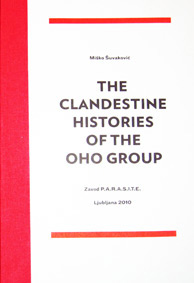
Soft Cover, English, Thread Stitching, 149 Pages, 2010,
The Clandestine Histories of the OHO Group
availability unknown, if interested please write an email
The book 'The Clandenstine Histories of the OHO Group' holds a new light to the problem of the character of neo-avant-garde excess and the experimental work of the OHO Group – leading neo-avantgard group in the region - in the second half of the 1960s. The book focuses on the practices, works, and instances with which – under the conditions of socialistic modernism – the OHO Group problematised, provoked, and destroyed the socialistic order of the vision of the autonomy of art
The book exposes the activity of the OHO Group (1966-1971) and of the movement OHO-Catalogue (1966-1970) in the context of Slovene national culture, Yugoslavian socialistic culture and international youth culture of the late 1960s and early 1970s, particularly in relation to the following paradigms:
1.'Transgression' – in terms of the breach in relation to Catholic traditions and morals as well as to the socialist work ethic that the young artists carried out at that time;
2.'Sexuality' – in style with the Zeitgeist and in connection with the worldwide sexual revolution on one side and the use of sexuality as a critical and subversive instrument rising up against the opportunism and hypocrisy of real-socialism on the other.
3.'Politics' – the provoking and mixing of practices from contexts – which were allowed by politics – to the context of a serious understanding and practice of the revolution and emancipation from 'the everyday grey' of real-socialism. At the end of the 1960s, the writer of new arts and activist, Bora Ćosić, wrote about the OHO Group: 'I call it a movement. The group looks like something static, something rooted, something buttoned up. The Group still holds firm, just like a machine-gun bunker; that a movement can operate as an illegal organisation, equipped with medicine, good will, and a feeling of freedom.'
The OHO Group was created in an atmosphere of new artistic practices: from the aesthetic, philosophical and social movements of reism, structuralism, poststructuralism and Tel Quel across to the New Left, hippy culture all the way to arte povere, body art, experimental film, conceptualism, processualism, post-object arts and ludism.
Miško Šuvaković is an internationally recognised theoretician, lecturer, writer, and curator, as well as one of the greatest connoisseurs of contemporary arts in the region. He is an honorary member of the Slovenian Society of Aesthetics. He achieved his doctorate at the Faculty of Fine Arts at the University of Arts in Belgrade and is a professor at the Faculty of Music Arts in Belgrade. Miško Šuvaković teaches theory of art in the interdisciplinary postgraduate study programme of the University of Arts in Belgrade. He is the author of numerous works on the field of contemporary visual arts, among them: Impossible Histories – Historical Avant-gardes, Neo-avant-gardes and Post-avant-gardes in Yugoslavia, 1918-1991 (The MIT Press, Cambridge, MA, 2003), Politics of Painting (Politike slikarstva) (Koper, 2004), Pojmovnik suvremene umjetnosti (Zagreb and Ghent, 2005), Conceptual Art (Konceptualna umetnost) (Novi Sad, 2007), etc.
